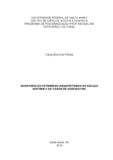| dc.creator | Flôres, Cáira Borondi | |
| dc.date.accessioned | 2021-08-13T18:09:59Z | |
| dc.date.available | 2021-08-13T18:09:59Z | |
| dc.date.issued | 2016-07-08 | |
| dc.identifier.uri | http://repositorio.ufsm.br/handle/1/21936 | |
| dc.description.abstract | The preserved architecture allows a materialization of the places’ memory; it transmits the
society events and creations to the future generations. The permanency of these buildings
keeps alive the collective city memory. So, this research has as the mainly objective to
inventory the buildings that are part of the city architectural history in Santiago, in the Vale do
Jaguari, in the Midwest of Rio Grande do Sul. The selected goods are part of the original city
history core, identified by this study and all of them respect the architectural, historical and
artistic values. This is an applied and qualitative research, with the purpose to preserve the
architectural patrimony; it’s descriptive when using the search for information and knowledge
from the happenings and goods. It uses a historical method, because it investigates the
buildings and their past processes; besides having a bibliography and documental approach,
looking for searching concepts related to the patrimony’s memory preservation and the
values as a classification method to the inventory. First, the historical core is demarcated, the
place where the city formation began, identifying the buildings from the three first decades of
the XX century with historical and architectural value and the ones that still remain their
original characteristics. Searching for more representative, these buildings were selected by
the ones that meet the requirement of having value or architectural, historical and artistic
quality, this way, six buildings from the historical core stand out. As a final product, it is
accomplished the goods inventory, that will serve as a base for the later preservation
processes through the community and public power. Besides a catalog production of the
inventoried buildings to contribute to the knowledge, that is a patrimony in the city and the
beginning of the Santiago’s collective memory preservation. | eng |
| dc.language | por | por |
| dc.publisher | Universidade Federal de Santa Maria | por |
| dc.rights | Attribution-NonCommercial-NoDerivatives 4.0 International | * |
| dc.rights.uri | http://creativecommons.org/licenses/by-nc-nd/4.0/ | * |
| dc.subject | Memória | por |
| dc.subject | Patrimônio | por |
| dc.subject | Arquitetura | por |
| dc.subject | Inventário de Santiago | por |
| dc.subject | Preservação | por |
| dc.subject | Memory | eng |
| dc.subject | Patrimony | eng |
| dc.subject | Architecture | eng |
| dc.subject | Santiago’s inventory | eng |
| dc.subject | Preservation | eng |
| dc.title | Inventário do patrimônio arquitetônico do núcleo histórico da cidade de Santiago/RS | por |
| dc.title.alternative | An architectural patrimony inventory of the Santiago’s city/RS history core | eng |
| dc.type | Dissertação | por |
| dc.description.resumo | A arquitetura preservada permite a materialização da memória dos lugares, transmite os
acontecimentos e criações de uma sociedade a gerações futuras. A permanência destas
edificações mantém viva a memória coletiva de uma cidade. Desse modo, esta pesquisa
tem como objetivo inventariar as edificações que fazem parte da história arquitetônica da
cidade de Santiago, localizada no Vale do Jaguari, centro-oeste do Rio Grande do Sul. Os
bens selecionados constituem parte do núcleo histórico original da cidade, identificado
através desse estudo e atendem aos valores arquitetônico, histórico e artístico. Esta é uma
pesquisa aplicada e qualitativa, com a finalidade de preservar o patrimônio arquitetônico; é
descritiva, ao utilizar o levantamento como busca de informações e conhecimento direto dos
acontecimentos e dos bens. Utiliza o método histórico, pois investiga as edificações e seus
processos do passado, além de ter uma abordagem bibliográfica e documental ao buscar
conceitos relacionados à preservação da memória, do patrimônio e dos valores como
método de classificação para o inventário. Primeiramente, o núcleo histórico é demarcado,
local onde a cidade principiou sua formação, identificando os prédios de valor histórico e
arquitetônico das três primeiras décadas do século XX e que ainda permanecem com
características originais. Buscando assegurar maior representatividade, dessas edificações
foram selecionadas as que atendem o requisito de ter valor ou qualidade arquitetônica,
histórica e artística. Assim, destacam-se seis edificações dentro do núcleo histórico. Como
produto final, é realizado o inventário desses bens, que servirá de base para posteriores
processos de preservação em meio à comunidade e poder público. Além da produção de
um catálogo das edificações inventariadas, para contribuição do conhecimento do que é o
patrimônio na cidade e início da preservação da memória coletiva de Santiago. | por |
| dc.contributor.advisor1 | Lopes, Caryl Eduardo Jovanovich | |
| dc.contributor.advisor1Lattes | http://lattes.cnpq.br/070182723809528 | por |
| dc.contributor.referee1 | Grigoletti, Giane de Campos | |
| dc.contributor.referee2 | Pereira, Clarissa de Oliveira | |
| dc.creator.Lattes | XXXXXXXXXXXXXXXX | por |
| dc.publisher.country | Brasil | por |
| dc.publisher.department | História | por |
| dc.publisher.initials | UFSM | por |
| dc.publisher.program | Programa de Pós-Graduação em Patrimônio Cultural | por |
| dc.subject.cnpq | CNPQ::CIENCIAS HUMANAS::HISTORIA | por |
| dc.publisher.unidade | Centro de Ciências Sociais e Humanas | por |



